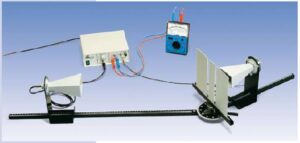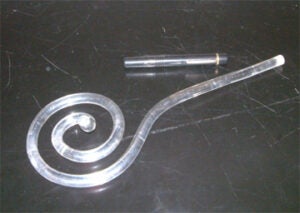O.1(1) – Ray Optics Laser System
This demonstration uses a Laser Ray Box (Wavelength – 635 nm) that project 5 parallel laser beams onto various flat surfaces. It contains a five 1 mW diode lasers. The optic set includes six magnetically-backed templates.
- Model of the human eye
- Camera
- Telescope
- Spherical Aberration
- Reflection and Refraction
Accessories include concave and convex lenses, prisms, mirrors and geometrical figures. They average 5 cm thick and 20 cm high, being highly visible for the whole class. All accessories are attached to the board using magnetic handles. This apparatus can be used to demonstrate index of refraction variations, total internal reflection, parallel deviation, prism behavior, etc.




O.1(2) – Refraction Tank
This demo is designed to show principles of refraction. The tank is placed in the center of a metal dish with a circular scale marked off in degrees on its edge. It consists of a semi-cylindrical acrylic strip, fitted on the front and back by semi-circular acrylic plates. Various experiments can be performed by rotating the laser/light along the disk.
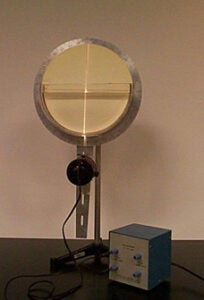


O.1(3) – Total Internal Reflection
There are many demonstrations for this phenomenon. The three previously mentioned demonstrations can be used: the Geometrical Optics Blackboard, the Optical Disk, and the Refraction Tank, where a ray of light is reflected internally at the surface between colored water and air. Other demonstrations are:
- Water Pipe: A clear plastic cylinder is filled with water and openings where water can flow. A laser beam is aligned exactly with this opening such that when the water is allowed to flow, it will show total internal reflection. The beam of light will be trapped on the water “tunnel” and it will be directed downwards with the stream of water.

- Lucite rod: An optical fiber and lucite spiral rod is included in this kit. The lucite spiral rod has its straight side connected to a light source (pictured below). Light is transmitted through the rod and can be seen on the other extremity.

- Light shower: The fiber optic set-up is lots of thin fiber optic cables attached to a light source and a rotator. As is rotates, the light transmitted through the optic fiber cables changes colors.
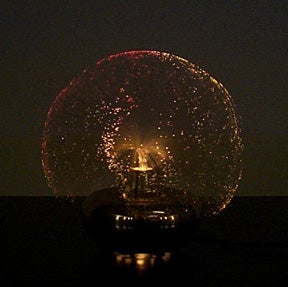
- Optical signal path generator: It allows one to observe the path of light through a typical optical fiber. Using a helium-neon laser as a light source, one will actually see how an optical fiber transmits light by total internal reflection. It consists on one straight and one curved bar made from transparent acrylic. Each bar has the dimensions 10 mm x 20 mm x 230 mm. They have frosted ends for interfacing with a light beam from a He-Ne laser. Place a clean white sheet on a flat surface in front of the laser to observe the light patterns.
O.1(4) – Lenses
Lenses of different sizes, focal lengths and types are available along with lens supports, optical benches and its accessories. These lenses can be arranged to show various effects and phenomena. As an example, a convergent lens forms a real image of a candle’s flame on a screen wall. The image in inverted.
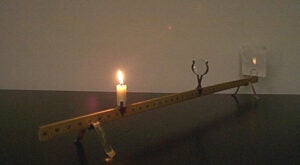
O.1(5) – Prism
A prism demonstrates the dispersion of white light into a spectrum. The demonstration is done on the optical board.


O.1(6) – Disappearing Beaker
This beaker, with no markings, bends light roughly the same as oil. Glass and oil have the same index of refraction. When the beaker is immersed into a container of oil, the beaker becomes invisible.
Click here to download the video clip of this demo.


Click here to see a video of this demo.
O.1(7) – Microwave Optics
In this experiment a microwave transmitter and receiver are used to study the properties of electromagnetic waves. Both receiver and transmitter are connected to a control box, which allows for transmitter signal amplification and for receiving signal options. The receiver signal can be observed through a voltmeter or as an auditory signal. The auditory signal is recommended for large classrooms where voltmeter observance may not be possible. The demonstration contains multiple setups that display straight-line wave propagation, penetration of a fiberboard screen, screening and absorption, reflection, refraction through a paraffin prism, diffraction, interference, and polarization. A variety of metal screen sizes are also included to give versatility in diffraction and interference pattern. This demo set may also be utilized to demonstrate principles regarding the speed of light.
